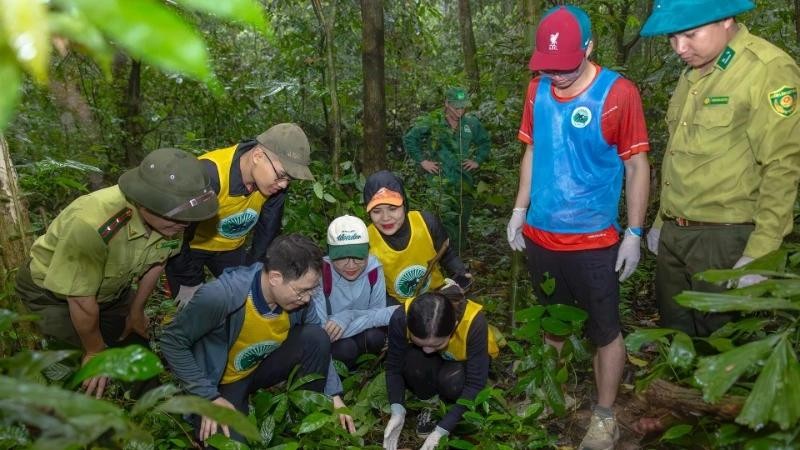
Visitors take part in the "Back home" tour at Cuc Phuong National Park.
Truly unique experience
This April, the pristine forest of Cuc Phuong in Ninh Binh has welcomed more “residents” returning to the wild. Under the eager gaze of over 20 tourists, a marbled cat civet dashed into the lush foliage the moment the cage door was opened, marking a poignant highlight of the “Back home” tour - an innovative tourism product launched by Cuc Phuong National Park.
Introduced in March 2021, the “Back home” tour allows visitors to witness and participate in the release of rescued wildlife back into their natural habitat. More than a simple tourist attraction, this programme is part of a long-term conservation effort that demands strict procedures, substantial resources, and unwavering dedication from the park’s experts. Once the animals have recovered and met the necessary conditions, they are returned to the primary forest.
Over the years, hundreds of releases have been conducted, involving thousands of animals across various species. According to Nguyen Van Chinh, Director of Cuc Phuong National Park, the ultimate goal of wildlife rescue is to return animals to the wild. The “Back home” tour conveys this message, connecting emotionally with visitors and spreading a spirit of responsible tourism.
“I believe anyone who witnesses such a moment - seeing an animal return to the forest - will be deeply moved. It naturally sparks a sense of duty to protect wildlife, not just while travelling, but in daily life,” said tourist Phan Van Tung.
Cuc Phuong is also a summer hotspot for nature lovers with its night-time electric vehicle tours to spot fireflies and observe nocturnal wildlife such as deer, pangolins, civets, jungle cats, otters, and slow lorises.
Responsible ecotourism initiatives are also being implemented in various other parks, including Phu Quoc, Cat Tien, Nui Chua, Cat Ba, Ba Be, Yok Don, and Pu Mat, as well as in nature reserves such as Pu Luong (Thanh Hoa) and Son Tra (Da Nang).
On 10 April, Con Dao National Park (Ba Ria - Vung Tau) launched its first multi-day ecotourism tours to islands known for sea turtle nesting, namely Bay Canh Islet, Bai Duong, Tai Islet, and Cau Islet.
Nguyen Khac Pho, Director of the park’s management board, stated that in response to growing demand for immersive nature-based experiences, Con Dao has carefully developed 5-10-day tours set to roll out in summer 2025. A total of ten tours are planned.
Before departure, visitors undergo training to familiarise themselves with Con Dao’s unique ecosystems, conservation principles, and basic survival skills. During the trip, participants will work alongside forest rangers, cleaning beaches, preparing nesting markers, maintaining hatching pits, and conducting night patrols to protect nesting areas, relocate eggs, and help release hatchlings into the sea.
Intersectoral coordination needed
Efficient management and sustainable use of natural resources, alongside biodiversity conservation, are key priorities in Vietnam’s Tourism Development Strategy to 2030. This form of tourism benefits local communities while minimising environmental and social impacts and preserving cultural and natural heritage.
However, implementing wildlife-related ecotourism is not an easy task. Pham Kien Cuong, Director of the Centre for Environmental Education and Services at Cuc Phuong National Park, emphasised the importance of adhering to strict conservation protocols to ensure tourist safety during animal releases.
Wildlife rescue, conservation, and release efforts are costly, and tour design requires careful research, making it unsuitable for low-cost competition. If poorly managed, this type of tourism can inadvertently pressure natural habitats. Therefore, close cooperation among tourism businesses, forest rangers, scientists, and local authorities is essential.
Experts suggest that in the near future, these tours should be further diversified to include more physical activities and be made more accessible to families with young children. A notable example is the ongoing success of the programme “Where are we going, douc?” on Son Tra Peninsula (Da Nang), which combines environmental education with nature experiences following the trail of the endangered red-shanked douc langur.
Primate conservationist Bui Van Tuan, Director of Hivooc Company, highlighted the need to enhance the value of biodiversity in Son Tra and other conservation areas through suitable tourism and educational efforts. According to the Department of Forestry (Ministry of Agriculture and Rural Development), national parks generate more than 2 trillion VND annually from forest tourism services — a vital source of funding for forest protection and local livelihoods.
Vietnam is home to nearly 180 conservation areas, which are rich in national and global biodiversity value, representing tremendous potential for experiential tourism and environmental education. Promoting nature-based tourism linked with wildlife conservation is not only a natural progression but also a vital strategy for sustainable development in the years ahead.
My Hanh - Do Hien - Translated by NDO